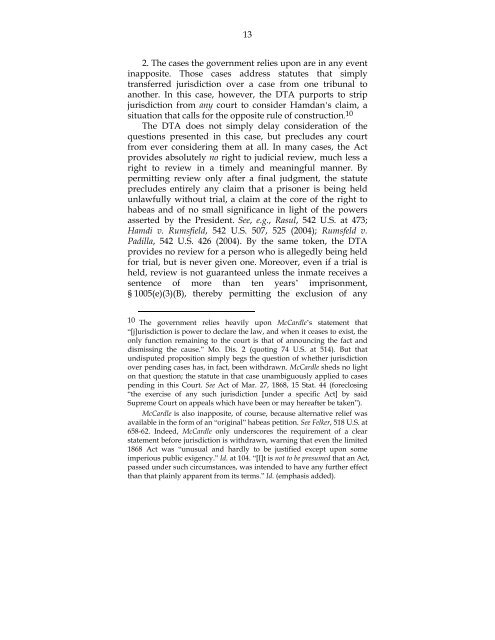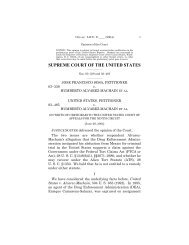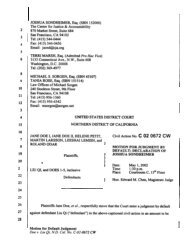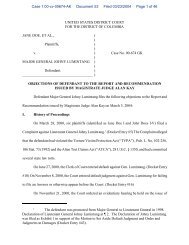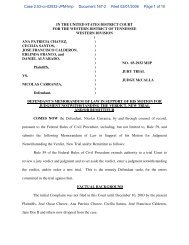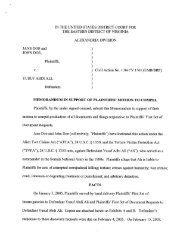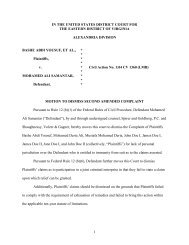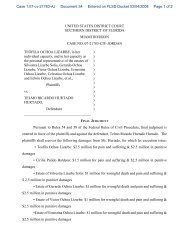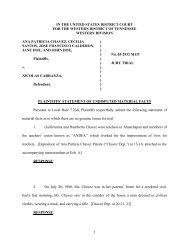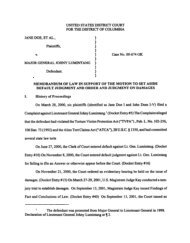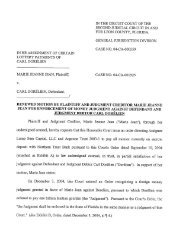Petitioner, v. Respondents. - Center for Justice and Accountability
Petitioner, v. Respondents. - Center for Justice and Accountability
Petitioner, v. Respondents. - Center for Justice and Accountability
You also want an ePaper? Increase the reach of your titles
YUMPU automatically turns print PDFs into web optimized ePapers that Google loves.
132. The cases the government relies upon are in any eventinapposite. Those cases address statutes that simplytransferred jurisdiction over a case from one tribunal toanother. In this case, however, the DTA purports to stripjurisdiction from any court to consider Hamdan’s claim, asituation that calls <strong>for</strong> the opposite rule of construction. 10The DTA does not simply delay consideration of thequestions presented in this case, but precludes any courtfrom ever considering them at all. In many cases, the Actprovides absolutely no right to judicial review, much less aright to review in a timely <strong>and</strong> meaningful manner. Bypermitting review only after a final judgment, the statuteprecludes entirely any claim that a prisoner is being heldunlawfully without trial, a claim at the core of the right tohabeas <strong>and</strong> of no small significance in light of the powersasserted by the President. See, e.g., Rasul, 542 U.S. at 473;Hamdi v. Rumsfield, 542 U.S. 507, 525 (2004); Rumsfeld v.Padilla, 542 U.S. 426 (2004). By the same token, the DTAprovides no review <strong>for</strong> a person who is allegedly being held<strong>for</strong> trial, but is never given one. Moreover, even if a trial isheld, review is not guaranteed unless the inmate receives asentence of more than ten years’ imprisonment,§ 1005(e)(3)(B), thereby permitting the exclusion of any10 The government relies heavily upon McCardle’s statement that“[j]urisdiction is power to declare the law, <strong>and</strong> when it ceases to exist, theonly function remaining to the court is that of announcing the fact <strong>and</strong>dismissing the cause.” Mo. Dis. 2 (quoting 74 U.S. at 514). But thatundisputed proposition simply begs the question of whether jurisdictionover pending cases has, in fact, been withdrawn. McCardle sheds no lighton that question; the statute in that case unambiguously applied to casespending in this Court. See Act of Mar. 27, 1868, 15 Stat. 44 (<strong>for</strong>eclosing“the exercise of any such jurisdiction [under a specific Act] by saidSupreme Court on appeals which have been or may hereafter be taken”).McCardle is also inapposite, of course, because alternative relief wasavailable in the <strong>for</strong>m of an “original” habeas petition. See Felker, 518 U.S. at658-62. Indeed, McCardle only underscores the requirement of a clearstatement be<strong>for</strong>e jurisdiction is withdrawn, warning that even the limited1868 Act was “unusual <strong>and</strong> hardly to be justified except upon someimperious public exigency.” Id. at 104. “[I]t is not to be presumed that an Act,passed under such circumstances, was intended to have any further effectthan that plainly apparent from its terms.” Id. (emphasis added).


